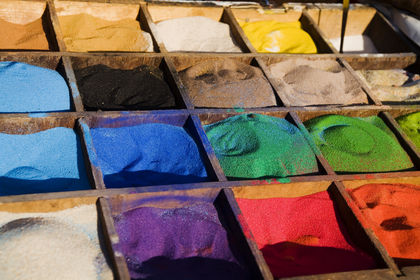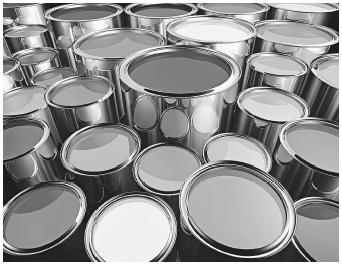Pigments

Pigments and dyes are called colorants. The ways in which colorants are used determines whether they are pigments or dyes. Pigments are water-and oil-insoluble natural and synthetic products that impart color to materials such as paper and plastics. Dyes, by contrast, are water-soluble colorants, although some are converted into insoluble lake pigments by coprecipitating onto an inorganic base. Artists' colors are pigments that are spread on a surface suspended in a suitable medium, such as oil. The mass coloration of textile fibers, polymers, plastics, and rubber takes place when pigments exist in the form of dispersions. A convenient way of classifying pigments is into organic and inorganic pigments.

Organic Pigments
Natural organic pigments were used in cave paintings and for decoration from the earliest times. The ancient Britons obtained indigo from the woad plant Isatis tinctoria , and used the extract to color their bodies. Here the insoluble blue is used as a pigment rather than as a dye. Other organic pigments found in nature include chlorophyll , the green coloring matter of leaves responsible for photosynthesis , and heme, which gives blood its red color and, when bound to proteins in hemoglobin, transports oxygen around the body. These biochemical pigments are members of the porphyrin family.
During the early 1930s synthetic organic pigments, called phthalocyanines, were developed in Britain and manufactured by Imperial Chemical Industries (ICI). Academic researchers showed that phthalocyanines are coordination complexes that mimic the structures of porphyrins. The coordination concept, involving groups of atoms called chelates attached to a central metal , was developed beginning in 1893 by the Swiss chemist Alfred Werner and confirmed in 1911, when he collaborated in Zurich with Victor L. King, later a leading technical expert in the U.S. colorant industry. Phthalocyanines represent the only structurally novel class of synthetic colorants invented in the twentieth century. Copper phthalocyanine, known as Monastral blue, and its congeners are used in automobile finishes, printing inks, and plastics.
Lake pigments made from the first synthetic dyes, such as mauve, were used during the 1860s for printing postage stamps and wallpaper. Red lake pigments, such as that derived from the madder dye, or after 1870 from synthetic dyes, were highly regarded by the Impressionist painters. Other synthetic organic pigments are made from azo dyes, those containing the −N=N− atomic grouping, introduced during the 1870s. The use of synthetic organic pigments in printing inks increased perhaps threefold in the last two decades of the twentieth century, as color became the norm in newspapers, magazines, advertising, and packaging. Careful standardization of the microcrystalline form, the crystal habit, is required for pigments employed in printing inks and paints. In order to add color to synthetic polymers, the plastics and resins, pigments are mixed in bulk with other chemicals during the manufacturing process.
Inorganic Pigments
Ultramarine, or lazurite, is a natural blue pigment derived from lapis lazuli, a semiprecious mineral of the sodalite group, found in Afghanistan. From around 1000 C.E. it was used as a pigment for illumination and later in murals and paintings. In 1271, the explorer Marco Polo visited the site where it was found. Artificial ultramarine, a blue pigment of variable composition, became available in Europe during the late eighteenth and nineteenth centuries. The German poet and dramatist Johann Wolfgang von Goethe, who was interested in color, visited one of the factories in 1787. Although the natural and synthetic forms of ultramarine are chemically similar, they differ in their particle forms. Prussian blue, iron hexacyanoferrate (III) or ferric ferrocyanide, is a synthetic dark blue pigment discovered in Berlin in 1704. It was originally made from animal matter, including blood, and the salts of iron.
Chromium pigments followed the discovery of the element in a rare Siberian mineral by the French chemist Louis-Nicolas Vauquelin in 1797. Lead chromate gives yellows and oranges, including chrome yellow, invented in 1809, and extensively used by artists, though often modified by addition of other ingredients. Also in 1809 George Field in England produced the dye lemon yellow, based on barium chromate.
Lead has been known and used since ancient times, in part because of the ease with which it can be isolated in the free state. It was converted into the dense pigment white lead (lead carbonate), an essential component of artists' palettes, including the Italian masters of the Renaissance. In the past lead was often used in white paint for the external protection of homes. However, lead is a toxic metal that induces swelling of the brain (lead encephalophy), and causes madness and death. Young children are particularly susceptible to its scourge. In 1910 the pioneer of American industrial hygiene, Alice Hamilton, selected as her first assignment at the Bureau of Labor an investigation of conditions in the white lead industry. Lead-based paints fell out of favor during the 1950s and were banned by the federal government during the 1970s. In modern paints, the toxic lead has been replaced by titanium dioxide.
Theories of Color
Color arises from the way in which colorants interact with light. Colored organic compounds contain groups of atoms whose bonds are unsaturated, such as C=C, C=O, and N=N. These are part of an extended delocalized system of electrons called a chromophore . A sequence of alternating double bonds through which the electrons are spread is termed a conjugated system. The presence of salt-forming groups of atoms such as –OH and NH 2 modify the color. They are called auxochromes and contain lone pairs of electrons that become part of the delocalized electron system. The nomenclature is based on the first successful theory of color and constitution, that of German chemist Otto N. Witt.
Colored inorganic compounds often contain transition metals in which the d subshell of electrons is split by attached groups, the ligands . The extent of this splitting is responsible for the color. The oxidation state of metals also affects the d electrons and determines color. When absorbed light brings about the transfer of an electron from the ground state of an atom to the excited state of a nearby atom, the process is electron or charge transfer. This accounts for the colors of Prussian blue and chrome yellow.
Although pigments have been associated with artists' paints, printing inks, and the coloration of synthetic polymers, they are also used in electronics and telecommunications, for the absorption of light, especially at semiconductor wavelengths, and in ink-jet printers, in addition to xerography (electrophotography) and thermography.
SEE ALSO Dyes ; Perkin, William Henry ; Werner, Alfred .
Anthony S. Travis
Bibliography
Ashok, Roy, ed. (1993). Artists' Pigments: A Handbook of Their History and Characteristics, Vol. 2. Washington, DC: National Gallery of Art.
Bomford, David; Kirby, Jo; Leighton, John; and Roy, Ashok (1990). Art in the Making: Impressionism. New Haven, CT: Yale University Press.
Feller, Robert L., ed. (1986). Artists' Pigments: A Handbook of Their History and Characteristics, Vol. 1. Washington, DC: National Gallery of Art.
Fitzhugh, Elisabeth W., ed. (1997). Artists' Pigments: A Handbook of Their History and Characteristics, Vol. 3. Washington, DC: National Gallery of Art.
Internet Resources
"Paint & Pixel." Available from http://www.total.net/~daxx/pap.shtml .
"Pigments through the Ages." Available from http://webexhibits.org/pigments .